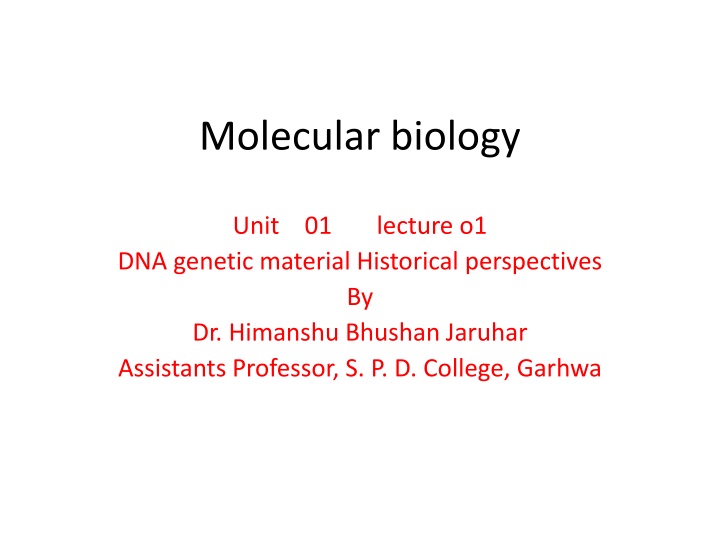Historical Perspectives on DNA as Genetic Material: From Mendelism to Griffith's Experiment
Mendelism's rediscovery in 1900 laid the groundwork for understanding heredity, leading to the association of Mendel's factors with chromosomes. The quest to identify the chemical nature of heredity began with Friedrich Miescher's discovery of nucleic acid in 1869. Despite initial confusion between nucleic acids in nucleus and cytoplasm, the pivotal role of DNA as the genetic material was eventually recognized. A shift from the protein-centric view of genes to DNA as the genetic material was solidified by Griffith's transformative experiment in 1928.
Download Presentation

Please find below an Image/Link to download the presentation.
The content on the website is provided AS IS for your information and personal use only. It may not be sold, licensed, or shared on other websites without obtaining consent from the author.If you encounter any issues during the download, it is possible that the publisher has removed the file from their server.
You are allowed to download the files provided on this website for personal or commercial use, subject to the condition that they are used lawfully. All files are the property of their respective owners.
The content on the website is provided AS IS for your information and personal use only. It may not be sold, licensed, or shared on other websites without obtaining consent from the author.
E N D
Presentation Transcript
Molecular biology Unit 01 lecture o1 DNA genetic material Historical perspectives By Dr. Himanshu Bhushan Jaruhar Assistants Professor, S. P. D. College, Garhwa
Molecular biology Unit 01 lecture o1 DNA genetic material Historical perspectives By Dr. Himanshu bhushan jaruhar Asistant Professor, S.P.D.College, Garhwa
introduction Mendelism was rediscovered in 1900 It was gained ground as physical besis of heredity. Sutton soon established a link between mendels factors with chromosomes. It gained ground as chromosomal besis of heredity It was not then clear what is the chemical nature of heredity.
introduction Biochemist focuussed on identify chemical nature of heredity. In 1869, freidrick Miescher devised a method to separate nucleus from the cytoplasm and called it nuclein. The nature of the nuclein was acidic thus it was called nucleic acid. Nucleic acid contains lots of phosphorus
introduction There are two types of nucleic acid are found one found in nuclein and other found in cytoplasm. Meischer believed that nucleic acid present in nuclein is unique and play a role in heredity. However he soon reject his hypothesis because his crude measuring technique incorrectly suggested that egg cells contain much more nucleic acid( actually called DNA) than the sperm cells. Reasoning that the sperm and egg must contribute roughly equal amount of heredity information.
introduction In early 1880s a botanist Eduard Zacharias reported - the extracting of DNA from the cell causes the disappearance of stain of the chromosome. Zacharias inferred that DNA is genetic material . This view prevailed until 1900s.
introduction From 1900to 1940s scientist believed that genes were made up of protein rather than DNA because: Chemically protein are comparatively more complex in structure and more diversity occurs in the cell than DNA. The more complexity means more possibility to contains more information Proteins are made up of 20 different amino acids that can be assembled in a vast number of combinations. DNA are simple polymer of only four nucleotides consisting of same sequences over and over, thereby lacking the variability expected for a genetic molecule.
Griffiths experiment In 1928 an English physician Frederick Griffith who was studying a pathogenic strain of bacteria called pneumococcus( pleuropneumococcus) which causes a fatal disease pneumonia in animals. That bacteria occurs in two strain called r strain and s- strain. R strain produces rough colony in agar culture because it lacks an envelop over its body and it is non pathogenic because it is attacked by immune system of the animal S strain is pathogenic and produce smooth or slimy colony because it has an envelope of mucous and slimy nature of carbohydrate. This envelope protect the bacterium from the immune system of the animal.
continue When a mixture of R strain and heat killed s- strain was injected into a mouse the disease appeared. It was surprised for the Griffith because neither R strain nor heat killed S- strain itself able to produce the disease. The autopsy of the mouse revealed the presence of the S- strain . Griffith concluded that the non pathogenic strain had some how converted into pathogenic strain by a substance present in the heat killed S bacteria. He called this phenomenon TRANSFORMATION. And the transforming substance as transforming principle.
Avery Mc Leyod and Mc Carty expt. After 14 years of Griffiths revelation of transforming principles three American Biochemist Oswald Avery, and his colleagues pursued the investigation of transformation. They fractionated cell free extracts of the s strain bacteria and found that only the nucleic acid fraction of the extract is capable of causing transformation. Moreover the activity of transformation was eliminated by treatment with deoxyribonuclease enzyme that specifically digest the DNA. This and other evidence convinced them that the transforming substance of the S- strain of bacteria was DNA.
Hershey and chase expt. In 1952 Alfred Hershey and Martha Chase designed an experiment with a bacteriophage virus T2 to address the question of genetic material T2 virus is made of only protein and nucleic acid DNA. To distinguish between two, they took advantage of difference between DNA and Protein. DNA contains Phosphorus but not Sulfur in its molecules. Proteins contains sulfur in amino acids Cysteine and Methionine but not phosphorus at all. They prepared two batches of T2 phage with culturing in S35 containg medium and P32 containing medium for several generations
continue By using radioactive isotope they were able to trace the facts of both protein and DNA during the infection process. They infected the bacterium with the mixture of the both batch of the phage and allowed to attach to the bacterial cell and inject their genetic material into the bacterial cell. Hershey and chase obtained empty coat of the phage by simple blending the culture and recovered the bacterium cell by centrifugation as a pellet. the data revealed that the coat of the phage contains most of the S35 while most of the P32 present in the DNA of the bacterium.
When the infected bacteria was cultured in the fresh medium in incubated longer some of the offspring had p32 but none with S35 isotopes. This was the first proven result of the DNA that it is the genetic material of the virus and Bacteria.
Franckel Conrad expt. RNA is genetic material in Tobacco mossaic virus In 1950, H Franckel conrad and his colleagues designed an expt. to find out whether the RNA or protein is the genetic material in RNA Virus. They separated the protein and RNA of the virus and inoculated them on healthy tobacco leaves. they took different strains of virus which are different in protein structure and type of symptoms produce. For example there is a HR strain in which methionine and histidine amino acid present but absent in most of the strain of the virus. Then they prepared a hybrid virus by combining the protein of the two strainwith the RNA of the other strain. The hybrid virus when infected the host the symptoms were analysed
continue The new virus had protein coat identical to the original virus from which the RNA had been isolated. In each case the symptoms were identical to those of the strain from which RNA had been isolated to construct hybrid Virus. They thus concluded that IN RNA virus RNA acts as genetic material not protein.























